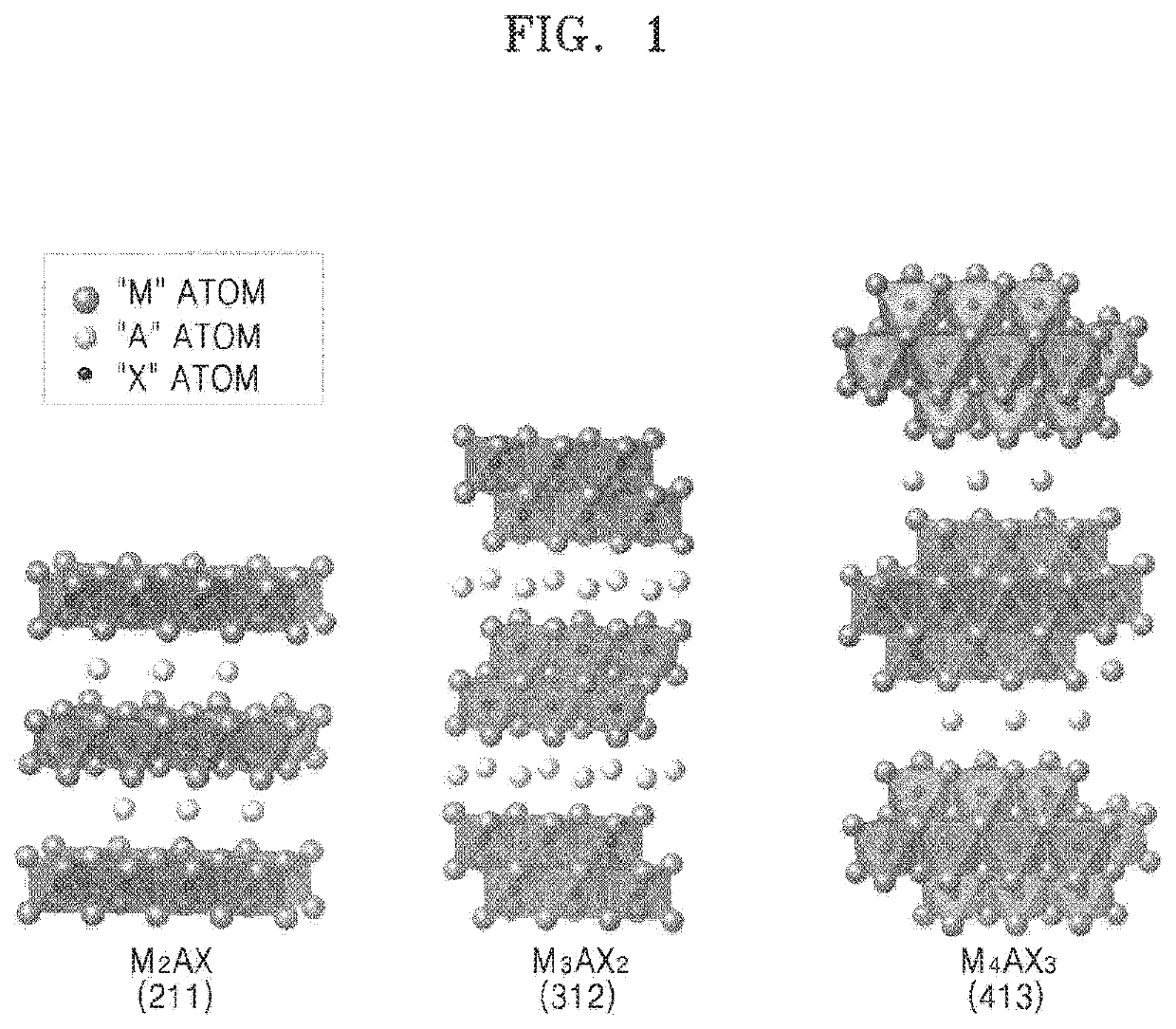MXene nanosheet and manufacturing method thereof
a technology of mxene nanosheets and manufacturing methods, applied in the field of mxene nanosheets, can solve the problems of deterioration of intrinsic properties of mxene, difficulty in modifying the two-dimensional structure using a general mechanical or chemical exfoliation method,
- Summary
- Abstract
- Description
- Claims
- Application Information
AI Technical Summary
Problems solved by technology
Method used
Image
Examples
preparation example 1
Synthesis of Ti3AlC2
[0088]Ti2AlC (MAXTHAL®-211, purchased from Kanthal) and TiC (purchased from Alfa asear) are mixed at a molar ratio of 1:1, followed by ball milling for 24 hours. The milled mixture of Ti2AlC and TiC was sintered by spark plasma sintering (SPS) at 1250° C. for 10 minutes to synthesize Ti3AlC2. Ti3AlC2 thus synthesized is subjected to sonication in methanol to prepare powder.
example 1
Preparation of Ti2C from Ti2AlC
[0089]1 g of Ti2AlC (MAXTHAL®-211, purchased from Kanthal) is mixed with 10 mL of 10% HF, and stirred at room temperature for 10 hours. The resulting product (Ti2CTs) from stirring is filtered with 1 L of water, and centrifugation is performed in order to remove impurities. Substances floating on water are collected and dried in a vacuum oven for 24 hours.
[0090]100 mg of the resulting product (Ti2CTs) is put in a flask and water is removed. 70 mg of Li metal is added thereto. 10 mL of ethylene diamine (EDA) is added under a nitrogen atmosphere, and a reaction is allowed at 25° C., 50° C. and 80° C. from room temperature to 80° C., respectively. Each of the reaction products thus obtained is neutralized with 500 mL of 5 wt % HCl, and filtered while successively washing with 1 L of water, 500 mL of ethanol, and 300 mL of acetone. After washing, the powder is dried in a vacuum oven at 120° C. for 2 days to obtain Ti2C.
example 2
Preparation of Ti3C2 from Ti3AlC2
[0091]Ti3C2 is obtained in the same manner as in Example 1, except that Ti3AlC2 synthesized in Preparation Example 1 is used as a starting material instead of Ti2AlC, 1 g of Ti3AlC2 is mixed with 10 mL of 50% HF, and this mixture is stirred at room temperature for 2 hours.
PUM
| Property | Measurement | Unit |
|---|---|---|
| temperature | aaaaa | aaaaa |
| temperature | aaaaa | aaaaa |
| temperature | aaaaa | aaaaa |
Abstract
Description
Claims
Application Information
 Login to View More
Login to View More - R&D
- Intellectual Property
- Life Sciences
- Materials
- Tech Scout
- Unparalleled Data Quality
- Higher Quality Content
- 60% Fewer Hallucinations
Browse by: Latest US Patents, China's latest patents, Technical Efficacy Thesaurus, Application Domain, Technology Topic, Popular Technical Reports.
© 2025 PatSnap. All rights reserved.Legal|Privacy policy|Modern Slavery Act Transparency Statement|Sitemap|About US| Contact US: help@patsnap.com



